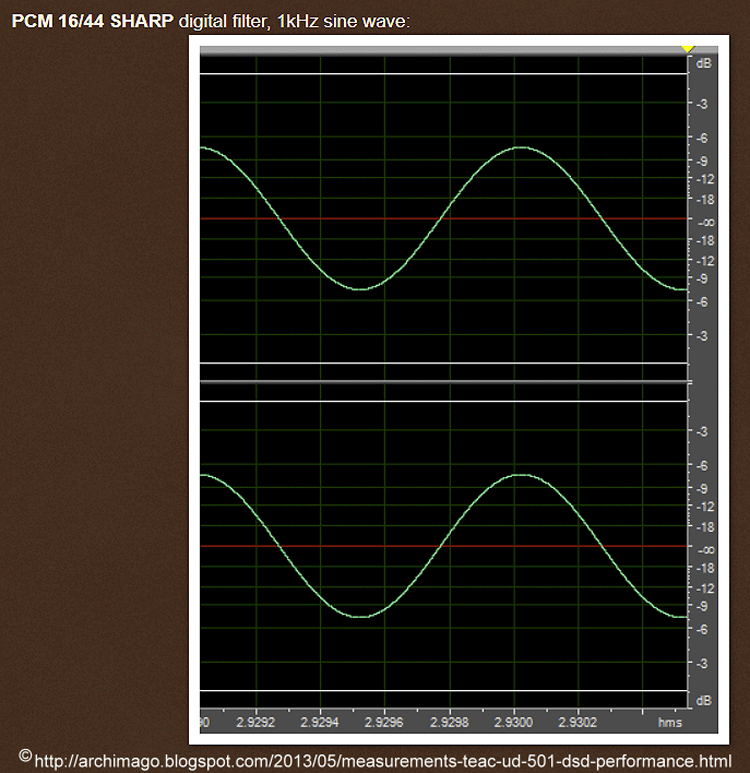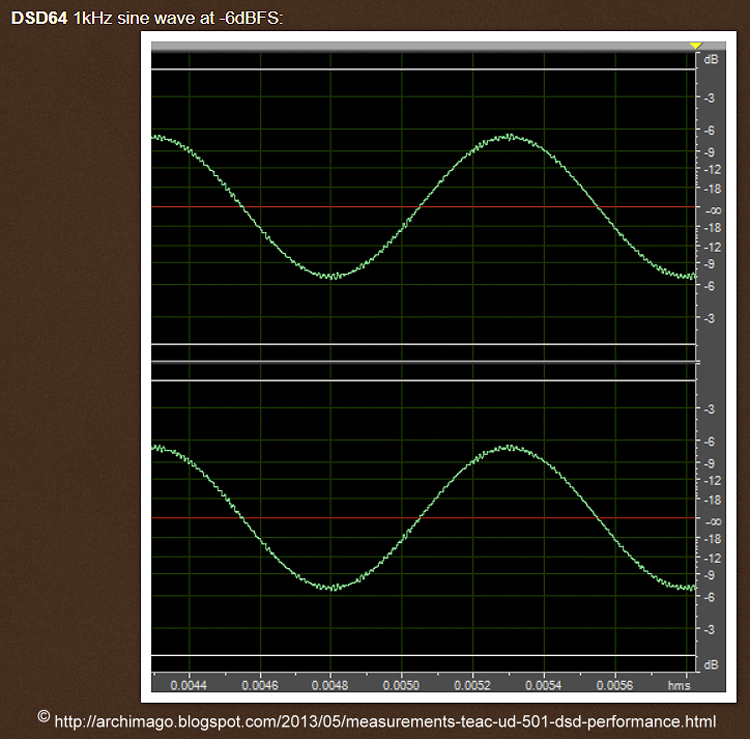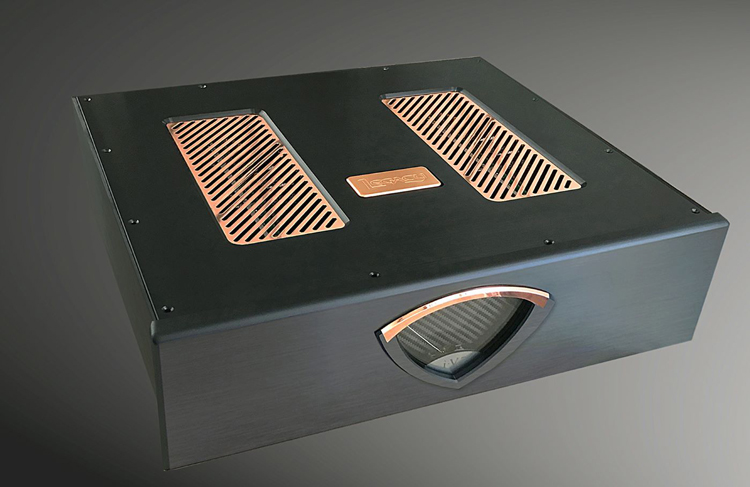
Each of the seven channels is capable of 610 watts of output at 8 ohms or 660 watts at 4 ohms. The Legacy is more than just power though. With a beautifully designed chassis and a sound quality on par with traditional amplifier designs, the Legacy Audio i∙V7 could be all the amplifier you’ll ever need.
Secrets Sponsor
The Legacy Audio i∙V7 multichannel amplifier is a true powerhouse of an amp. It offers a massive amount of power across all seven channels for exceptional dynamics and output. Starting with its incredibly low noise floor, the iV7 builds from there with great bass slam, an exceptionally clean midrange, and excellent treble detail.
Legacy Audio i∙V7 Multichannel Amplifier
- Seven-channel Class D Power Amplifier
- 610 watts per channel into 8 ohms, 660 watts into 4 ohms
- Amazingly lightweight
- Cool running
- Closes the performance and quality gap between Class D and traditional Class AB designs
Legacy Audio should be a name familiar to anyone who has followed the high-end audio, professional audio, or home theater market in the past 20+ years. Probably best known for their excellent speakers, Legacy Audio, under the leadership of Chief Designer Bill Dudleston has delivered multiple award-winning products. I had the pleasure of reviewing the excellent Legacy Audio Signature SE speakers back in 2017 and Jim Clements reviewed the monster Foundation subwoofer in 2018. However, Legacy Audio also makes electronics, including some very innovative DSP circuitry and the new i∙V7 multichannel amplifier we have here today. Touted as Legacy’s most powerful amp to date, the i∙V7 uses the new ICEedge® Class D amplifier modules. Class D has had its criticism (some of it justified), but its key attributes of high-efficiency, high power, a low noise floor, great bass control, and typically neutral midrange response have led more and more designers to consider Class D for their designs. Recent advances in the technology have generated a slew of new amplifier modules. Names such as NCore, Anaview, Abletec, Pascal, Purifi, and ICEedge® have started showing up inside the amplifiers of more and more well-regarded brand names.
I personally made the jump to Class D nearly ten years ago, using a high-powered seven-channel amp based upon the original ICEpower® modules. While I have been very happy with my current amplifier, I always thought that there were a few key areas where Class D didn’t quite live up to the best Class A, A/B, or tube designs, particularly in the areas of sound staging, treble reproduction, and overall musical realism. When I saw the announcement that Legacy Audio would be introducing the i∙V line based on the latest generation ICEedge® modules, I knew I had to get one of these amps in my system. Are these new Class D modules an improvement upon the prior generation? Has the gap between Class D and traditional amplifier designs been eliminated? Let’s see how the Legacy Audio i∙V7 answers those questions.
Number of channels:
7
Power Rating:
610w x 7 @ 8 ohms, 660w x 7 @ 4 ohms, all channels driven
Peak Power:
1.2kw peak power from any channel @ 4 ohms/1kHz with less than 1% distortion
Maximum Sustained Power Consumption:
2100 W @120VAC on a 20-amp circuit, 4200 W @120VAC on a 40-amp circuit (2 x 20-amp circuits)
Frequency Response:
Not specified
Damping Factor:
750 average, 20Hz to 1kHz
Voltage Gain:
25.8dB
Dynamic Range:
127dB, A-weighted
Voltage/Current:
98 Vp/38Ap
Input Sensitivity:
5.0 Vp @ 1200W/4 ohm
Input Impedance:
38 Kohm for both pin 2+ and pin 3-
Channel Separation:
120dB at 1kHz
Inputs:
7 x fully balanced XLR, 7 x single-end RCA
Outputs:
7 x gold-plated five-way binding posts
Dimensions (W x H x D):
17.5” x 5.8” x 15.6”
Weight:
31 lbs.
Warranty:
3 years
MSRP:
$7,550
Website:
Company Directory:
SECRETS Tags:
Legacy Audio, i-V7 Multichannel Amplifier, Multichannel Amplifier, Amplifier, Amplifier Review, Review, Review 2021
Legacy Audio’s i∙V amplifiers are available in configurations of two (the i∙V2, MSRP $4,350) through eight channels (the i∙V8, MSRP $8,250) of amplification. Each model shares the same basic chassis and design. While there is only so much you can do with a box that might need to fit into a rack-mount, the Legacy Audio i∙V7 multichannel amplifier is a very attractive-looking amplifier in my opinion.
The main chassis is constructed of thick aluminum with a brushed black finish and feels very solid. The heat vents, Legacy badge, and upper piece of the front power meter are all finished in polished copper, which gives the i-V7 a very distinct and classy look. To further differentiate the i-V7 from the crowd, Legacy has placed a cool, v-shaped “power meter” on the front face. The face of the meter is carbon fiber and there is a single needle that will move as the overall current draw increases. There is also a small LED light at the center position of the meter’s face. The light glows blue when the amp is in operation and amber when in standby. While the light is not too bright, I would like to see a way to dim the output when the i∙V7 is powered on. The blue light was fairly noticeable while I was watching movies in the dark, even behind the perforated metal door of my equipment rack. There is also a “Standby” power switch under the right front face. Don’t forget to switch that on, even if you are using the 12v trigger from a pre-amp to control the amplifier. Around back, you have seven RCA inputs and seven XLR inputs for fully-balanced operation along with seven pairs of very solid-feeling five-way binding posts for connecting your speaker wires. Rounding out the back panel is the main power switch, a 12v trigger input, a 15A breaker, a single IEC power cord input, and a small knob to adjust the needle’s center position on the front power meter. Four round metal feet anchor the amp to your mounting surface.
Everything feels very solid, and the overall fit and finish are excellent. One thing I did notice the first time I dusted the amplifier is that the screws on the top chassis plate are not flush. They stick up about a millimeter or so. I’d like to see Legacy countersink these better so that they are even with the top plate. I would also like to see some other color options, at least for the accent pieces, as copper doesn’t readily match with many other equipment brands. On the other hand, copper does stand out.
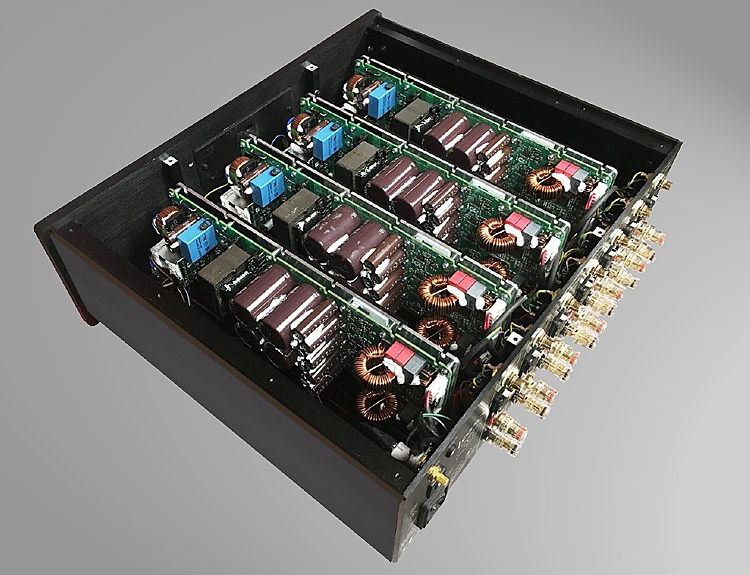
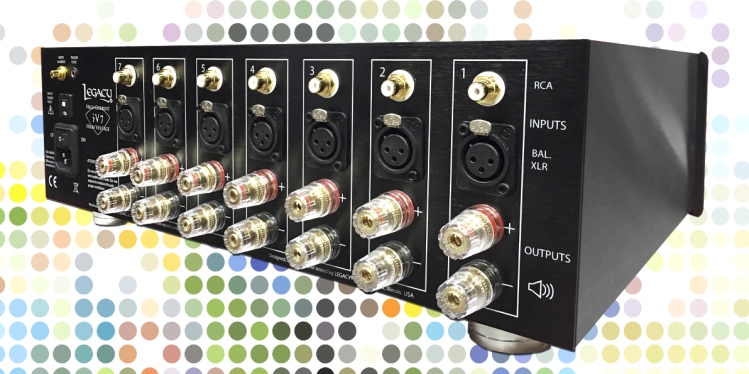
Inside the i∙V7 is where things get really interesting. At the heart of the i∙V7 are the new ICEedge® amplifier modules. As there have been several recently released Class D modules, I asked Legacy’s Bill Dudleston what drew him to the ICEedge® design in particular and if there were any key areas that Legacy had to work around to deliver such a powerful multi-channel amp. Here is what he had to say on the matter: “Not only is their custom ICEedge® 3-piece chipset controller state of the art, but the execution of the physical build is unsurpassed. This carries through to the large amount of thermal heatsinking which we couple to our solid aluminum brackets and chassis. I think the internal cable harness development for the seven-channel amplifier is more complex because the 1200-watt ICEedge® modules are so remarkably capable. Offering fully balanced inputs along with the ability to monitor real-time voltage and current, provide short-circuit protection with thermal sensing, triggered on/off, along with EMI filtration is a designer’s dream. Toss in both +5V for digital circuits and a +/- 15V auxiliary supply for analog gain stress and you have one heck of a toolkit.”
As for the design goals of the i∙V line, Mr. Dudleston had the following to say: “We wanted the listener to experience pristine uncolored amplification with seemingly unlimited power. The amplifier needed to be extremely low in noise to provide a background of silence to take advantage of 24-bit dynamic range, and efficient in operation at these high power levels. The design had to meet Legacy’s stringent standards for reliability and drive a wide range of load impedance.” Along these lines, Legacy spent extra time working on providing the lowest noise floor possible.
Again, to quote Mr. Dudleston: “Attention to the grounding scheme was essential. With very careful design of the chassis, grounded mounting brackets, and individually soldered connecting points grounding each heatsink, we were able to drop the noise floor a few extra dB.”
There are four internal power supplies, each shared by two channels, except for channel seven, which is dedicated to a single speaker. Each of the four power supplies can output as much as 1200 w (@4ohm) to its connected speakers at any given time. This shared approach leads to some special setup, which I will talk about in the “setup” section. On a single 20-amp circuit the i∙V7 can draw a maximum of 2100 watts across all four power supplies before maxing out the line. With the 80% efficiency rating on the ICEedge® modules, this translates into roughly 1,680 watts of power available to your speakers. That is still a ton of power but far less than the 4,800-watt potential output of all four power supplies. If you purchase the 8-channel i∙V8, Legacy includes a “dual head” power cable that allows you to connect two separate 20-amp lines to the single IEC power input giving you 40 amps of current and 4,200 watts of total system draw which works out to roughly 3,360 watts of output. For those of you with multiple 20-amp circuits, I would strongly recommend stepping up to the i∙V8 for this reason. $700 extra would buy you nearly double the available wattage to your speakers and gain you an extra channel of amplification to boot. Why would anyone need this much power? Besides freedom from potential clipping, high SPL levels, and big dynamics, take a peek at our Op-Ed: Is Your System 24-bit Ready? with Mr. Dudleston himself for a more detailed explanation. Even with this tremendous amount of power, the i∙V7 should never really get much more than “warm,” even under high output levels. Legacy took extra care to ensure that the heat sinks from each ICEedge® module were directly coupled to the aluminum chassis, effectively increasing the size of the modules’ heat sinks. The heavy-duty mounting brackets for the modules were designed in a vertical arrangement to allow for adequate airspace between units and for heat to naturally rise out of the chassis. As long as you leave some open space above the i∙V7’s chassis to allow the heat to escape you should never run into any thermal issues. I had about 3” of open space in my setup and never noticed the amp get much more than warm to the touch.
Setting up the i∙V7 was about as easy as could be. The amp arrived in a thick cardboard box and was held in place by sturdy foam inserts. The amp itself had a velvet cover with the Legacy Audio logo stitched on it – a very classy touch. While a complete copy of the user manual was not included in my box, a PDF version is easily found on Legacy’s website. In typical Legacy Audio fashion, the manual is well-written and very comprehensive with lots of additional but pertinent information. After perusing through the included spec sheet, I went ahead and slid the i∙V7 into my equipment rack in place of my reference Wyred4Sound multichannel amp. As I was swapping out one seven-channel amp for another, all my wiring was ready to go. I plugged in the power cord and then proceeded to connect my Marantz AV8801 pre-amp to the i∙V7 via Blue Jeans Cable XLRs.
Remember how I mentioned that the four separate power supplies within the i∙V7 mean you need to pay attention to how you connect your speakers for optimal performance? With each power supply driving two speakers, you want to make sure that your highest power drawing speakers are either on their own dedicated power supply or shared with one of your less demanding speakers. Following Legacy’s advice, I wired my speakers and XLR connections up as follows:
Power Supply 1:
Channel 1: Left Front
Channel 2: Left Back Surround
Power Supply 2:
Channel 3: Right Front
Channel 4: Right Back Surround
Power Supply 3:
Channel 5: Left Surround
Channel 6: Right Surround
Power Supply 4 (dedicated to a single speaker):
Channel 7: Center
I connected the 12v trigger feed from my pre-amp, flipped on the main power switch on the back panel, turned on my preamp, and . . . nothing. Fortunately, because I read the manual (they really do come in handy sometimes), I remembered the second “standby” switch on the face of the amplifier. Flipping that on brought the amp to life and the little light on the front power meter started glowing amber. Now when I turned on my preamp, the light switched to blue and the needle moved to the “center” mark on the meter. The needle was hovering just a bit to the right of the center mark so I turned down the adjustment knob on the back panel and voila – the needle was now perfectly centered with no sound playing.
For this review, the source material was played exclusively via my Oppo UDP-205 Blu-ray player, connected to my Marantz AV8801 pre-pro by Blue Jeans Cable XLR and HDMI runs. Kimber 4VS speaker cable (bi-wired for the left/right channels) was used on the front three channels to connect my Sonus faber Olympica III towers and Olympica Center. Audioquest 14 gauge in-wall wiring was used to connect my Olympica I surrounds and Sonus faber Venere Wall back surrounds. My trusty Hsu Research VTF-3 MkII and ULS-15 MkII subwoofers rounded out the speaker package. Legacy Audio does not mention any recommended “break-in” time for the i∙V7 so I didn’t spend weeks “burning it in.” I did not hear any noticeable change in the amplifier’s sound over the three months I used the amp either. I did find that the i∙V7 benefitted from some “warm-up” time, with the amp sounding slightly smoother after 15-30 minutes of use. Given the efficiency of the amp and its very low heat output, those of you who like to leave your amps on all the time should have no issue doing so. Now with all of that out of the way, it was time to hear how the Legacy Audio i∙V7 sounds.
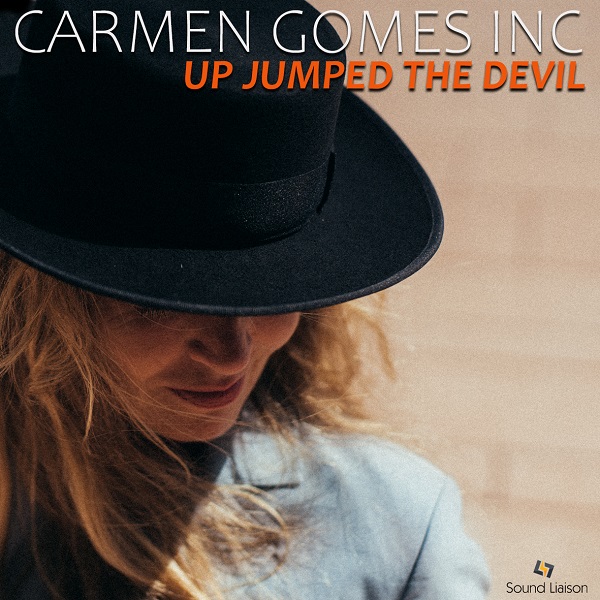
Carmen Gomes, “Up Jumped the Devil”
Even though the i∙V7 is a multi-channel amp, I started off with some high-quality stereo tracks to get a feel for the overall sound and capabilities of the powerful Legacy. I was also very curious to see if there were any noticeable differences between my reference ICEpower® (ICEpowered?) amplifier and the newer ICEedge® modules. I ran my Marantz AV8801 in “Pure Direct” mode to shut off all processing as well as the subwoofers and switched to the XLR outputs on my Oppo BDP-205 to get the purest signal.
Carmen Gomes’ latest album, “Up Jumped the Devil” (Sound Liaison 24-bit/352.8kHz DXD file) is another fantastic sounding album from the team at Sound Liaison. While every track sounds great, “Ease the Pain” is probably my favorite on this album. Right from the start, the dynamics and rhythm of the bass grabs you and doesn’t let go. Then the sweet guitar practically jumps out from the silence at your ears. Gomes’s guitarist is quite adept at controlling the output of his guitar just with his fingers and pick attack and I could really hear that fantastic technique come through via the i∙V7. Notes higher up the fretboard still had a nice bite but the initial attack never struck me as harsh or overemphasized. As Gomes joins in, her flawless vocals show that the Legacy could present a very neutral midrange and lower treble. I could easily hear the subtle inflections in her voice.
Imaging seemed very good too, with her voice emanating from the space between my left and right speakers. The soundstage certainly had some width and depth to it, but the i∙V7 presented this as more of a small, intimate stage. The natural bass that drives the groove of this song was really taut, with natural depth and fullness. The cymbals had a nice shimmer and each brush of them had a very long, natural decay. I had run through all of my demo tracks with my reference Wyred4Sound ICEpower® equipped amp right before swapping out for the i∙V7 so I had some pretty fresh audio memories in my mind to compare the Legacy too. While the bass and much of the midrange presentation seemed similar to my reference amp, dynamics seemed livelier and the upper midrange and treble presentation was significantly better. These cymbals didn’t have the same level of detail and airiness through my reference amp as they did through the i∙V7. The upper midrange and treble just seemed to be “clearer” through the i∙V7. What really struck me was that there seemed to be so much more musical details in the treble and upper midrange but I wasn’t hearing any of the brightness or edginess I associate with amps this articulate. The majority of the “graininess” I typically associate with Class D treble (and is present in my reference amp) was dramatically reduced. If I listened very closely, I could occasionally hear a slight haziness in certain notes, but only on occasion. However, unless you were doing a back-to-back comparison or have extensive listening time with very good tube, Class A, or A/B amps I doubt most people would notice. Class A has its own sound character. Class A/B has its own character. Class D has its own character. All of them now sound really good, including Class D.

Rachmaninoff, “Symphonic Dances”
My positive impressions continued with well-recorded classical. As I am so familiar with the tracks, I put on “Little Red Riding Hood and the Wolf” and “Lento Assai” from Rachmaninoff’s “Symphonic Dances” (Reference Recordings, 24-bit/96kHz FLAC file). I was highly impressed with the very “black” background that let the music jump out at you. Both of these tracks are very dynamic and the i∙V7 continued to show its prowess here. The swells of the massed strings during “Little Red Riding Hood” were incredibly powerful, as was the opening minute and a half of “Lento Assai.”
Playback really did sound effortless for the Legacy. The i∙V7 drove my Olympica IIIs with exceptional control, delivering incredibly tight-sounding kettle drum thwacks complete with natural decay and reverberation.
The midrange continued to impress with woodwinds and strings sounding balanced and beautiful, with excellent clarity. Emotionally, the i∙V7 was far more engaging than my reference amplifier. Once again, the most impressive aspect of the sound was the treble. The bells and chimes from the 2:00 to 3:00 minute mark in “Lento Assai” sounded phenomenal. They truly sparkled with shimmer and air but yet never came across as too bright. The i∙V7 presented a well-defined soundstage, and it was fairly easy to hear where each instrument was placed on the stage. As I noted with the Carmen Gomes tracks above, I have heard more expansive sound staging from other high-quality amplifiers, but I still felt that the i∙V7 was markedly better than my reference amp. Two-channel musical purists may still prefer the overall sound from a high-end tube or Class A or A/B amplifier, but these new ICEedge® modules and Legacy’s implementation of them have really leveled the playing field.
As I knew how good the i∙V7 sounded from my two-channel listening, I skipped over my usual selection of surround-sound music (DVD-Audio and SACD discs) and just went straight to some of my favorite lossless film soundtracks. The arrival of an LG 77” GX series OLED (See Chris Eberle’s review of the 65” model here) at the start of my time with the i∙V7 also gave me the perfect excuse to use the i∙V7 as I would imagine most of its purchasers would: in a high-end home theater setup. As expected, the i∙V7 just gave me more of what I loved during my stereo listening, just with more channels and even more volume.

The first 4k Blu-ray disc I pulled off my media shelf was “The Matrix.” While I can probably recite this movie line-for-line, watching it in HDR (and with the proper color tone – finally) combined with the spectacular Dolby Atmos soundtrack was like seeing the movie for the first time. Right from the intro scene, it was obvious that the i∙V7 was made to show off a good multichannel system. I skipped forward to the infamous “Lobby Shooting Spree” and bumped up the volume to near reference-level. All I can say is WOW! The clarity of the dialogue from my center channel was amazing and you could even make out the marble-lined rooms reverberation/echo as the security guard tells Neo and Trinity to remove their metallic objects.
And then the bullets start flying. The gunshots were loud and punchy, but even with so many occurring at once, I could still distinguish the distinct note from each type of firearm. Overall dynamics were exceptional, with no sign of strain even with the volume cranked beyond 95dB. As I heard with stereo sources, the real star was the treble definition. The tinkling of expended brass hitting the floor and the splintering of the marble walls was the most realistic and airy I’ve yet heard in my system. As expected, the elevator explosion was awesome but was even better was the sound of the sprinkler system going off right afterward. Even without actual height speakers, the clarity of the showering water emanating from all the speakers completely enveloped me in the scene.

Picking another “old stand-by” off my shelf, I loaded up the 4k UHD of “Gladiator.” Right from the start, the DTS-X soundtrack sounded the best I’d ever heard in my system. The beautiful woodwind and classical guitar notes as the film starts up sounded absolutely beautiful. As it fades to the dream scene of Maximus walking through his fields, you could clearly hear his hand brush each individual strand of wheat. I don’t think I’ve ever noticed this detail before, and I have heard this soundtrack dozens of times on many different systems over the years. Serious credit to the i∙V7 for bringing out this subtle little detail. The introductory battle scene truly did “Unleash Hell” in my media room with all channels firing at full volume.
Again, the overall dynamics were great, with no hints of distortion or strain anywhere in the sound field. Tone and timbre were perfect across all channels, a key advantage of using the same amplification and matched speakers for each channel. As good as the dynamics were, the scene where Maximus and his ill-fated band of gladiators enter the Colosseum for the first time was even better. The explosion of sound from the massive crowd as the men come up the dark ramp and out onto the floor was simply epic. The i∙V7 simply made scenes like this even more fun to watch.
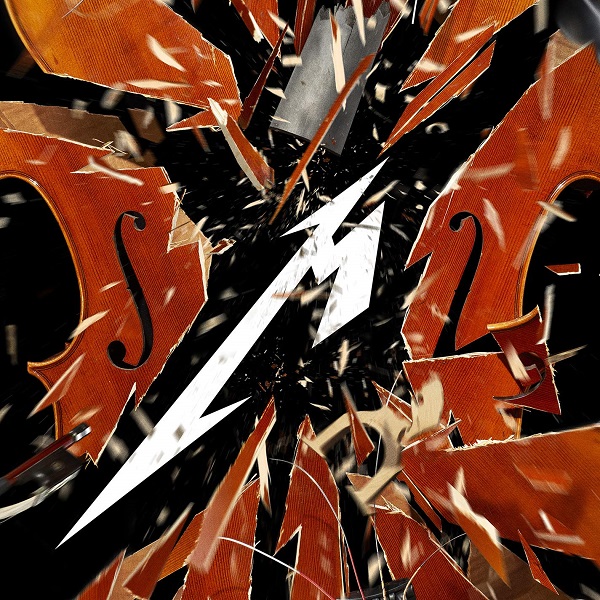
Metallica, Symphony and Metallica 2 (S&M2)
The live concert Blu-ray disc of Metallica’s Symphony and Metallica 2 (S&M2) concert also arrived during my time with the i∙V7 and this disc really showcased the powerful Legacy’s overall quality. S&M2 did a fantastic job of capturing a great band in what could be one of their best performances ever. Unlike the somewhat lackluster audio quality of the original S&M recording, S&M2 got the love that it deserved. The San Francisco Symphony sounded spectacular, and it was clear that the production team took great pains to ensure that their wonderful playing was captured properly on the DTS-HD Master Audio 5.1 track.
The symphony was given plenty of time to shine on their own, from the intro “Ecstasy of Gold” to a dedicated performance from the Scythian Suite, “Opus 20 II: The Enemy God and the Dance of the Dark Spirits.” The kettle drums sounded amazing. It was easy to hear the flutter of the drumskins as the deep notes shook my room. The winds came rising up with authority but remained delicate and sweet sounding. Brass had the appropriate bite and upper midrange attack without ever becoming too harsh. The bass solo “Anesthesia – Pulling Teeth” by the San Francisco Symphony’s Scott Pingle was a real highlight of the show for me.
Sawing away on an electric stand-up bass, Pingle captured the raw energy of Cliff Burton’s original, while adding a whole new level of beauty and drama. This emotional performance really came through with the i∙V7. When Lars Ulrich joins in with his drums towards the end, the energy level shoots through the roof and you could feel the crowd’s enjoyment of the performance through the surround channels. James Hetfield’s solo performance of “All Within My Hands” was another standout for me. While it was odd to see James without a guitar in his hands, the combination of the symphony and his vocals showed a depth in Metallica’s artistry that I had never seen before. James’ trademark voice was in fine shape through the whole song, and the i∙V7 captured his signature growl well. He even shows a larger vocal range than I think I’ve ever heard out of him before. Of course, concert playlist favorites like “One” and “Wherever I May Roam” sounded great too. Even if you aren’t necessarily a fan of Metallica, I’d recommend that you give this disc a listen. I was playing these tracks at around 95dB and a quick check of the meter on the front of the i∙V7 showed that it was barely operating at 20% capacity, even on musical peaks with all channels driven. Very impressive indeed!
Class D amplifiers are not digital. The “D” is just the letter in the alphabet that was available when the technology was invented.
They are called “switching amplifiers.” That is because the voltage is switched on and off for varying lengths of time depending on where on the waveform the signal is to be located. If it is, for example, at the low end of the rising portion of the + half, the voltage is switched on for a very short time. If at the peak of the wave, then it is switched on for a longer time. This varying amount of time being switched on is called Pulse Width Modulation, or PWM, where width is the time that the voltage is switched on.
Here is a simplified circuit diagram of a Class D amplifier (one channel):

A signal generator uses a triangular-shaped signal at a specific frequency (the switching frequency), somewhere between 250 kHz and 1.5 MHz to reproduce the incoming music signal. In the case of the i∙V7, it is at 500 kHz. So, the voltage is switched on and off 500,000 times each second, for varying lengths of time, with one output transistor (usually MOSFET) handling the positive portion of the waveform, and a second one handling the negative portion.
Here is a representation of the varying lengths of time during one complete waveform cycle:
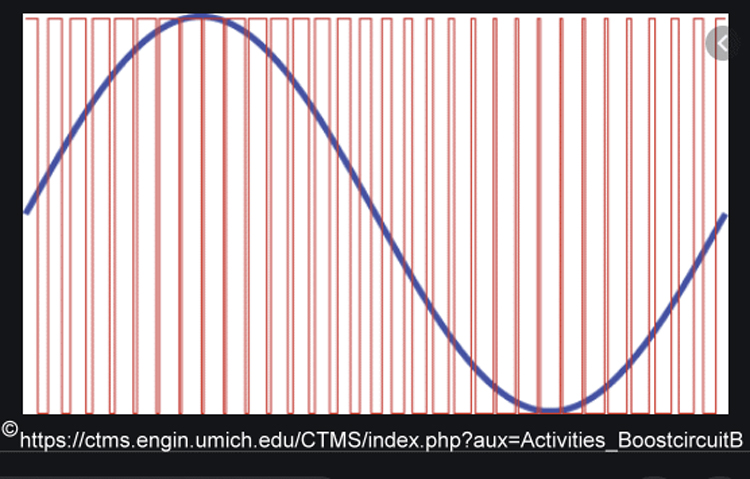
The diagram below shows a waveform that is conventional analog (continuous voltage swing, no switching on or off, no digital bitstream), PCM digital, where 16 or 24 bits (1’s or 0’s) code for a specific voltage on the waveform, and DSD, where the bitstream uses a 1 to indicate an increase in the voltage from the previous bit, and a 0 indicates a decrease in the voltage from the previous bit. For PWM, the analog switching frequency generator results in the analog voltage being switched on or off. There are no 1’s or 0’s here. For DSD64, the voltage is increased or decreased 2.8 million times per second. For DSD128, it is 5.6 million.
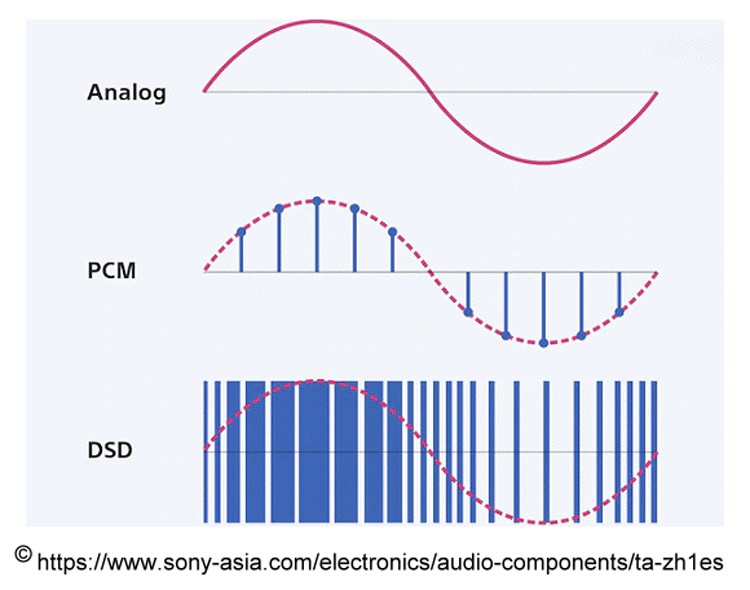
Here is a spectrum of the waveform for 1 kHz PCM and DSD64. You can see in the DSD64 waveform the voltage increasing or decreasing.
Now, examine this PWM waveform (below). It looks a little like the DSD64 waveform, but again, PWM is analog, not digital.
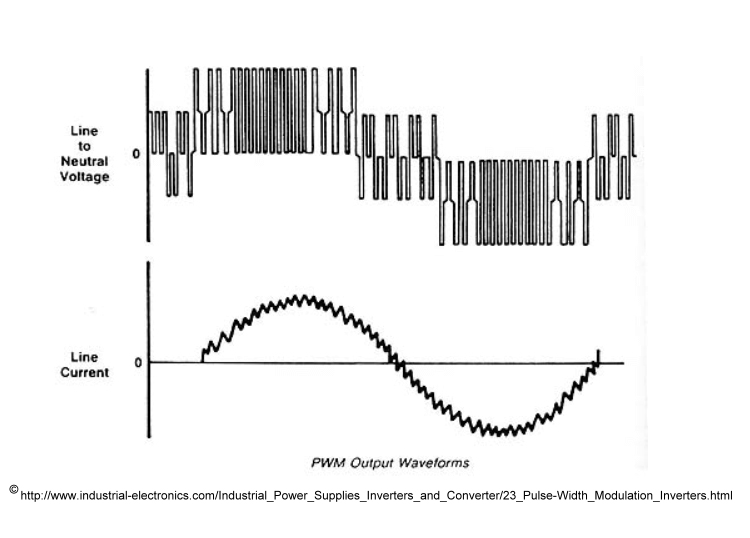
So, for the i∙V7, at 20 kHz, the voltage is switched on and off 500,000 divided by 20,000 = 25 times, but each time it is switched on, the length of time it is on varies.
The switching frequency creates a peak on the spectrum in the amplifier, and it has to be removed (reduced, not completely removed in practice). This is done with a low-pass filter consisting of an inductor and capacitor, much like as done for the woofer in a speaker. The LC filter, usually a 2nd order filter for 12 dB/octave response reduction, can be made to work at whatever frequency is desired, but what is wanted is to reduce the switching frequency peak by at least 60 dB. Even though the switching frequency peak is far above audibility, it can cause problems in the amplifier because it is so high (it could be called radio frequency interference).
Here is a schematic for a simple 2nd order low-pass LC filter. “L” is the inductor, and “C” is the capacitor.
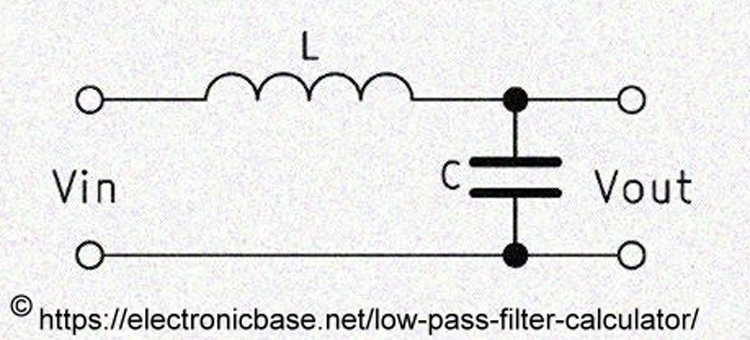
Noise shaping is used to move quantization noise out of the audible band. Noise shaping is dithering (the addition of noise at the same level at all frequencies) at different amounts at different frequencies. Here is an article on dithering and noise shaping that I wrote a few years ago.
The result is an amplifier with 80% – 90% efficiency, meaning you will get more power out of the amplifier from your 120 Volt wall socket than you would with a conventional Class A/B amplifier. Less heat is generated so more of the energy is used for music.
I have to say here that the Legacy Audio i∙V7 amplifier truly surprised me. I could get 600 watts out of two channels at the same time without causing a big problem for my UPS (Uninterruptible Power Supply). I can barely do 500 watts from a single channel testing a Class A/B amplifier. Amplifiers are becoming so powerful; I need to get a 240 Volt-to-120 Volt converter-regulated power supply to test these big amps. A good one is about $5,000. It may be a while.
So, you have heard Tyler’s listening tests. Now, on with the bench tests.
Complete List of JJ’s Reference Components: OPPO BDP-105 Universal Player (4), OPPO UDP-205 Universal Player (2), VPI-HR-X Turntable with Sumiko Blackbird MC Cartridge and Sumiko Palo Santos MC Cartridge, AURALiC ALTAIR G1 Digital Audio Streamer, Manley Labs Steelhead Tube Phono Preamplifier (2), Balanced Audio Technology VK-5i Pure Class A Triode (Tube) Stereo Preamplifier (2) (Fully Balanced), Balanced Audio Technology VK-500 Solid State Stereo Power Amplifier (Fully Balanced) (250 Watts per Channel), Pass Labs Xs Preamplifier, Pass Labs Xs 300 Monoblock Pure Class A Power Amplifiers (2) (300 Watts/each), Parasound JC 1+ Monoblock Power Amplifiers (2), Lamm LL1 Signature Stereo Pure Class A Triode (Tube) Preamplifier, MartinLogan CLX Full-Range Electrostatic Speakers (2), Sonus faber Lilium Speakers (2), Paradigm Reference Signature SUB 2 Subwoofers (2), Custom-Built Computer for Audio Analysis, Accupel HDG-3000 Digital Color Signal Generator (1080i capable), Component Video and DVI Output, ColorFacts Pro Video Test and Calibration Software, Version 6.0, Spyder Sensor, SpectraPlus Audio Analysis Software, Audio Precision SYS-2722 Spectrum Analyzer, Staco 3PN2210B-DVM 22 Ampere Variable Transformer (for adjusting line voltage to 120 volts during amplifier power output tests), Pass Labs XP-20 Stereo Preamplifier, Classé SSP-800 Surround Sound Processor, Emotiva XMC-1 Surround Sound Processor, Classé CA-5200 Five-Channel Power Amplifier (200 Watts per Channel), Pass Labs X600.8 Power Amplifiers (4) (600 Watts/Each), Audio Control Phase Coupled Activator (Sub-Harmonic Generator), Carver Platinum Mark IV Ribbon Speakers (2), MartinLogan Summit X Hybrid Electrostatic Speakers (2) (Rear Left/Right), MartinLogan Stage X Hybrid Electrostatic Speakers (3) (Center and Sides Left/Right), MartinLogan Balanced Force 212 Subwoofer, Velodyne DD-18+ Subwoofer (3), HiFiMAN HE1000 Planar Magnetic Headphones, OPPO PM-1 Planar Magnetic Headphones, OPPO HA-1 Headphone Amplifier, Bryston BUC-1 USB Converter, Sony VPL-HW55ES 1,920 x 1,080p Digital Projector, 90″ (Diagonal) Stewart Grayhawk Projection Screen, Sony 75″ UHD (4K) Flat Panel Display, Clarus Audio and Wireworld cables, Clarus Concerto Power Conditioner with Crimson Power Cable.
Here is 1 kHz at 2 Volts output. THD+N is a little more than 1%. This is due to the noise rather than the harmonic distortion peaks. You can see a 2nd order peak, but any other harmonics are lost in the noise.
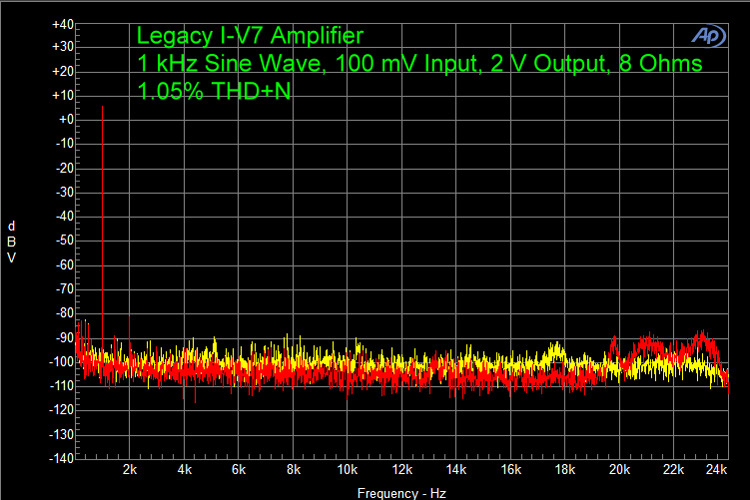
At higher output, there are more harmonics, but THD+N is lower because although the same noise is there, the signal peak is higher, so the percentage of the signal that is distortion plus noise is lower. There are visible harmonics all the way out to 24 kHz.
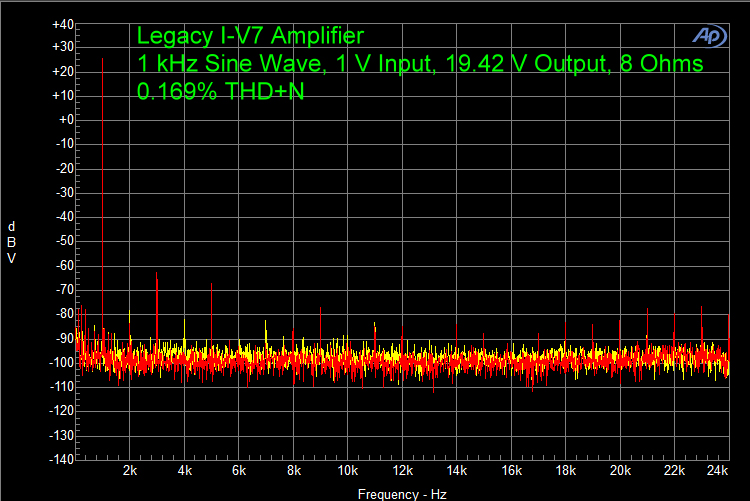
Here is a hum spectrum with the test signal on. The primary peaks are all even-ordered at 120 Hz, 240 Hz, 360 Hz, etc.

With the test signal off, the hum spectrum has the same peaks, but at a lower level, out to 600 Hz.
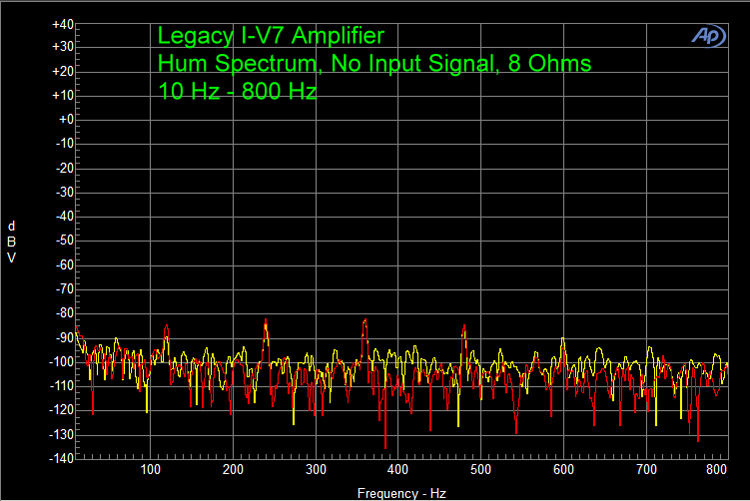
Using a 4 Ohm load, THD+N is a bit more than doubled compared to the same voltage into 8 Ohms, but most of this appears to be a noise increase rather than large increases in harmonic peaks.
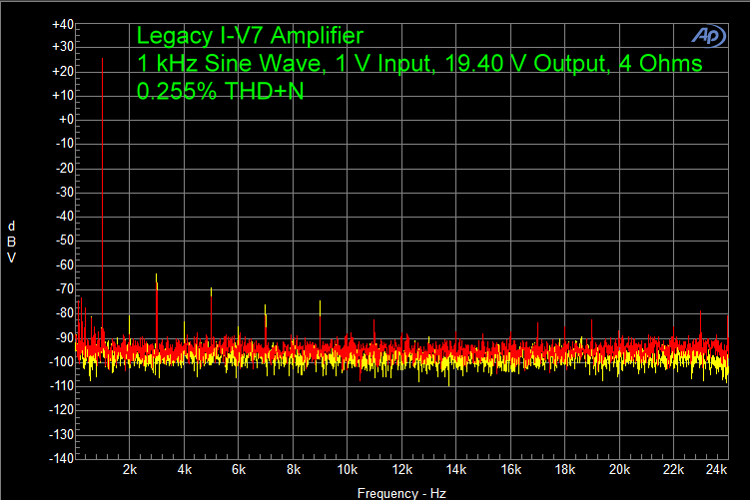
The Legacy i∙V7 can deliver 600 watts per channel into 8 Ohms. Let’s take a look at a spectrum close to the rated output. In this spectrum (below), two channels output 68.89 Volts (593 watts) at less than 1% THD+N (the definition of the output specification is the wattage at clipping, which is 1% THD+N). The noise is high (relatively), and there are plenty of harmonic peaks, but on the spectrum, you can see that the output signal is at a high dBV, in this case, specifically, it is 36.76 dBV. The highest distortion peak is the 3rd harmonic, at minus 29 dBV, which is 0.035 Volts. That 3rd order peak is 0.05% of the signal peak. This is approximately what is expected of a Class D amplifier, i.e., a distortion value of 0.05%. I calculate this here because the noise factor contaminates the THD+N value. But, even as such, noise is at -90 dBV, which is 0.00003 Volts (hum is not included in this, which is at -76 dBV).
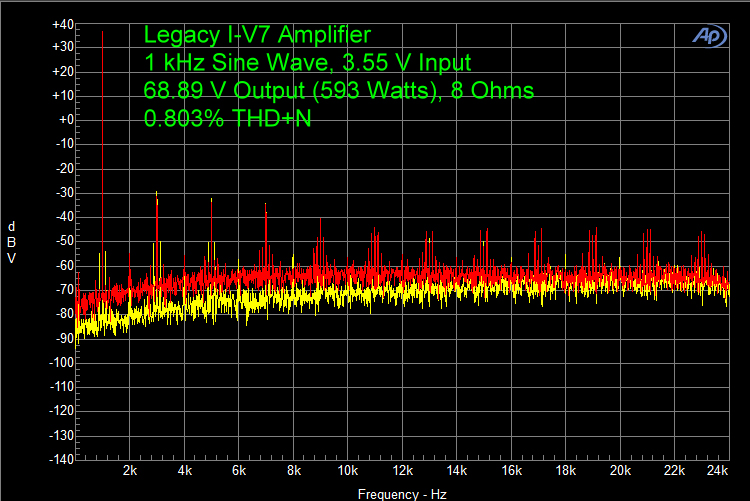
Using 19 kHz and 20 kHz sine waves at a low voltage output into 8 Ohms, there is not much evidence of intermodulation (below). There are some spurious peaks farther out on the spectrum.
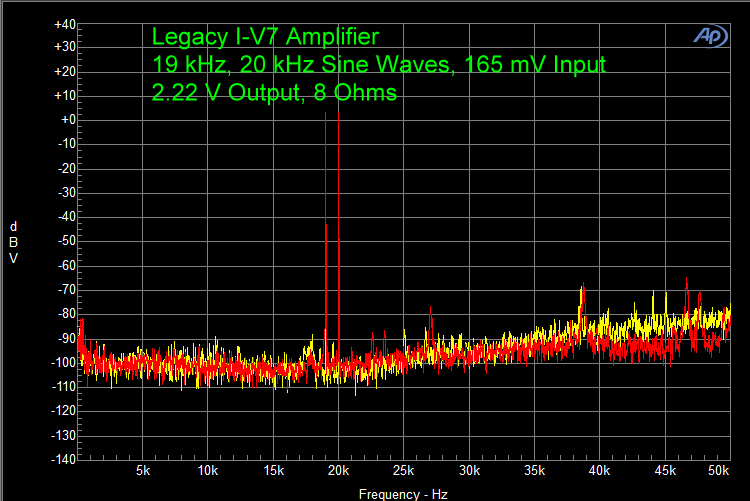
With a higher output, there is more obvious intermodulation. The increase in noise at 25 kHz and higher is noise shaping that is used to reduce quantization noise in Class D amplifiers.
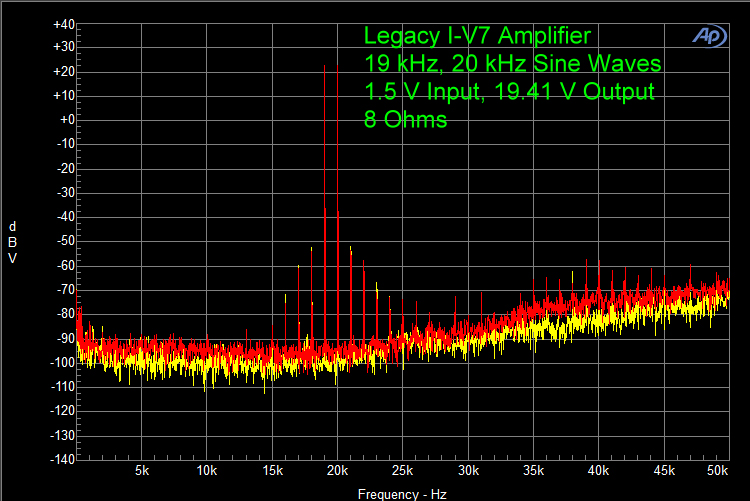
Changing to a 4 Ohm load results in more IM peaks, but it also twice the wattage even though the voltage is the same.

The use of 60 Hz and 7 kHz sine waves is also standard for testing IM distortion. Here it is with a low voltage output into an 8 Ohm load. IM is 0.847%.
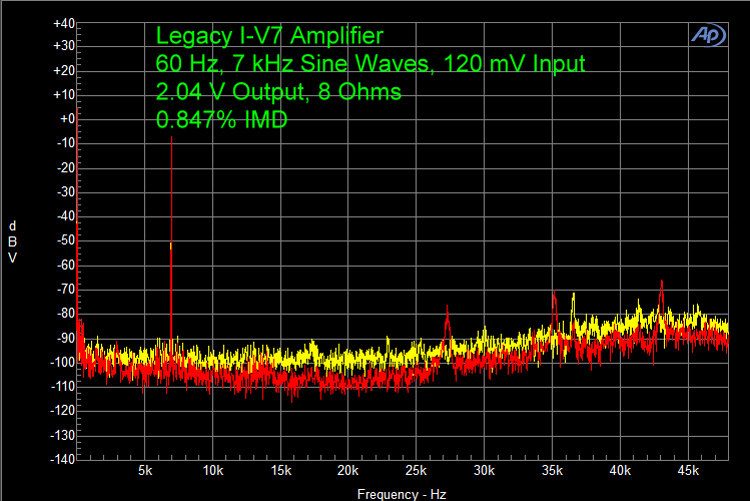
At the higher output, IM is reduced, again because it is a smaller percentage of the total power.
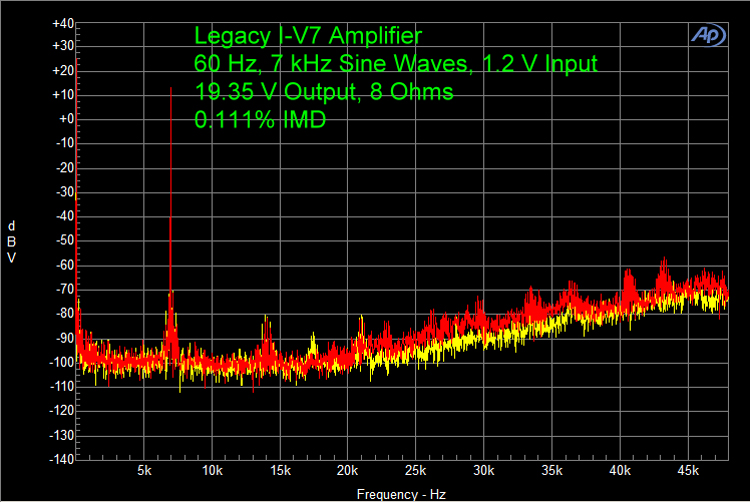
With a 4 Ohm load, IM is a little higher, at 0.16%.
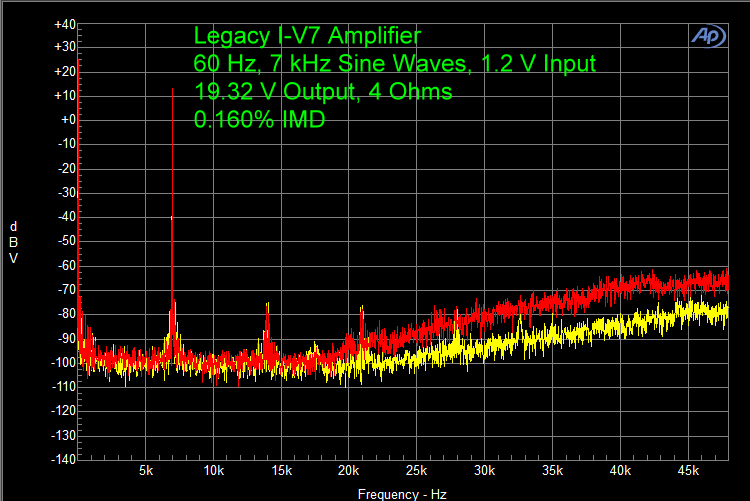
THD+N vs. Frequency is shown below at two different voltages. It is relatively flat all the way out to 50 kHz.
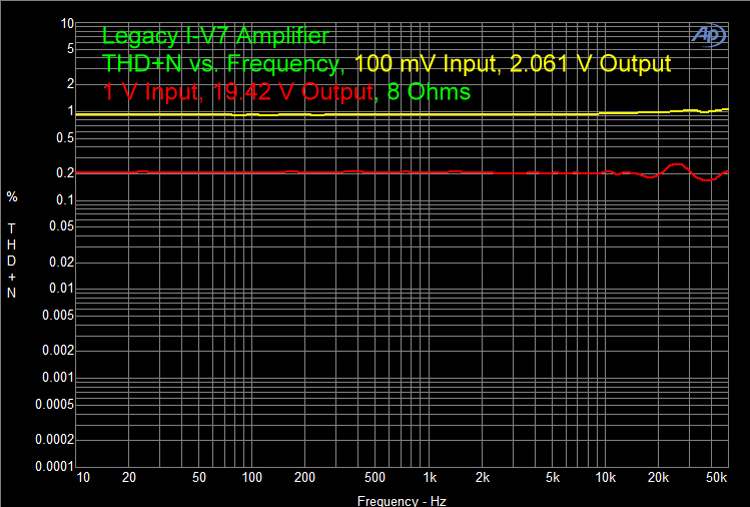
THD+N vs. Power. The graph represents the noise rather than THD. At very low output, the noise is the predominant factor, and that is why it is near 80%. When performing the THD+N vs. Power test, noise all the way out to 500 kHz is included in the measurement so as to pick up any RF noise. Since noise shaping at 90 kHz is present at high levels, and although it is out of the range of audibility (by design), it results in a high number (THD+N) on the graph. That is why I performed the 1 kHz sine wave test at 593 watts output in graph # 6 shown above, as noise only out to 80 kHz is included in the measurement.
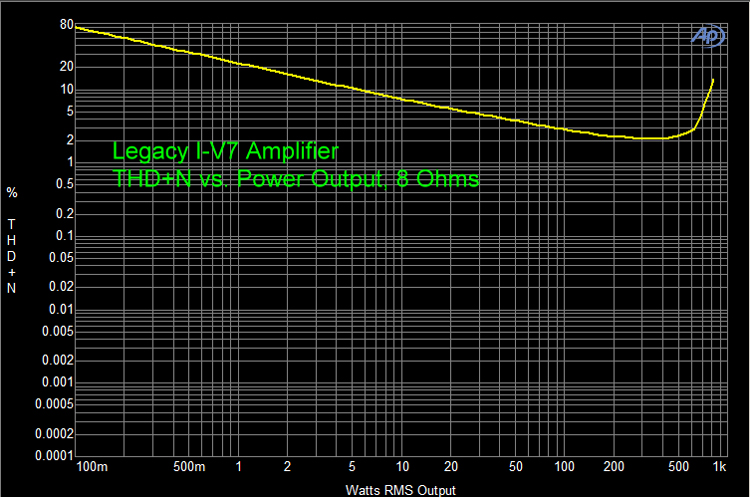
The frequency response is shown below. It does not change very much at 4 Ohms vs. 8 Ohms. This is different than what is seen with many Class D amplifiers where the response near 20 kHz is slightly increased at 8 Ohms compared to 4 Ohms, so the Legacy i∙V7 amplifier is the latest technology. That’s good because it means you don’t have to worry about speaker impedance so much.
The peaks around 90 kHz represent the noise shaping. The response declines rapidly after that point due to the low-pass filter at approximately 100 kHz. To reiterate, the low-pass filter is used to reduce the peak at the switching frequency (500 kHz).
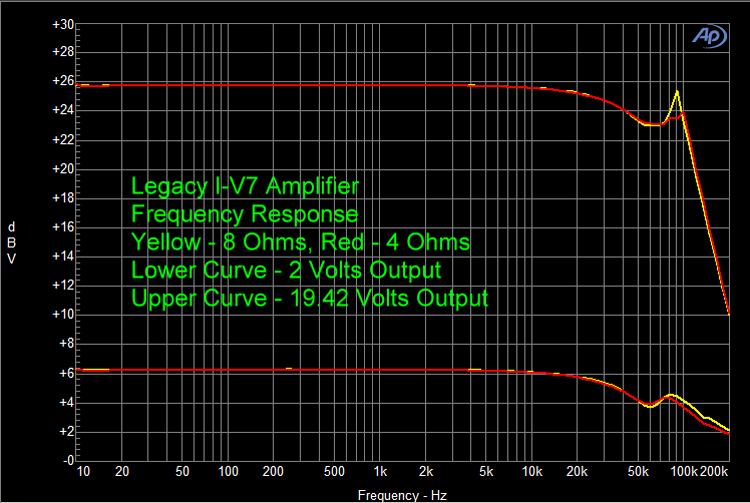
To sum up, I am very impressed with the performance of the Legacy i∙V7 Class D seven-channel power amplifier. Its efficiency allows the amplifier to output very high wattage in several channels at the same time without blowing a wall socket fuse. You would not be outputting 600 watts in all seven channels for more than a fraction of a second during dynamic peaks. Distortion is well controlled.
Secrets Sponsor
I think this technology is the future for surround sound amplifiers. If I were setting up a new home theater surround sound system, I would get this amplifier without hesitation. I would use it for the center channel and all the surround channels, including two height channels in the front. I would use a Class A or Class A/B amplifier for the front left and right channels since I would be using those channels for listening to stereo music.
Well done Legacy Audio!
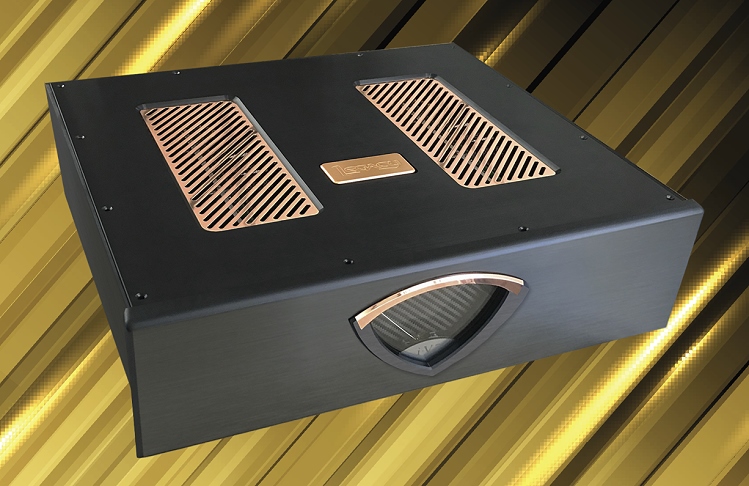
Excellent build quality, massive power reserves, and excellent performance make the Legacy Audio i∙V7 multichannel amplifier a great buy for a top-tier system.
- Clean, sleek design
- Rock-solid build quality
- Relatively small and light chassis
- Incredible amount of power for all seven channels
- Very “black” background
- Impressive dynamics
- Tight, hard-hitting bass
- Very natural midrange presentation
- Exceptionally detailed treble without harshness
- Very neutral presentation of the source
- Cool power meter
- Still a touch of the “Class D treble grain” compared to the best solid-state/tube amps
- Soundstage width and depth presentation not quite as “big” as some other reference-level amplifiers
- Countersink the top chassis screws
- Other finish choices would be nice (at least for the accents)
- Dimmable power light
To paraphrase the words of a certain blue Genie voiced by Robin Williams, the Legacy Audio i∙V7 amplifier offers seven channels of phenomenal cosmic power in a relatively itty-bitty living space. Perhaps even more importantly, there is no longer any need to “justify” your decision to go Class D. The i∙V7 does pure power, dynamics, and bass better than pretty much any competitor on the market without sacrificing performance in the midrange or treble. The impressively neutral midrange and detailed, yet still sweet treble response bring music and film soundtracks to life. Musical backgrounds are incredibly quiet, helping the sound to “jump” out at you. The new ICEedge® modules are a noticeable step up from the last generation ICEpower® units and really help to close the gap between Class D and the best Class A/B, or G multichannel units. If you need a powerful multichannel amplifier for your home theater or dual-purpose system and have quality speakers and source gear, the Legacy i∙V7 or any of the other Legacy i∙V models would be a fine choice. I am seriously contemplating picking up one of these for my own system.






